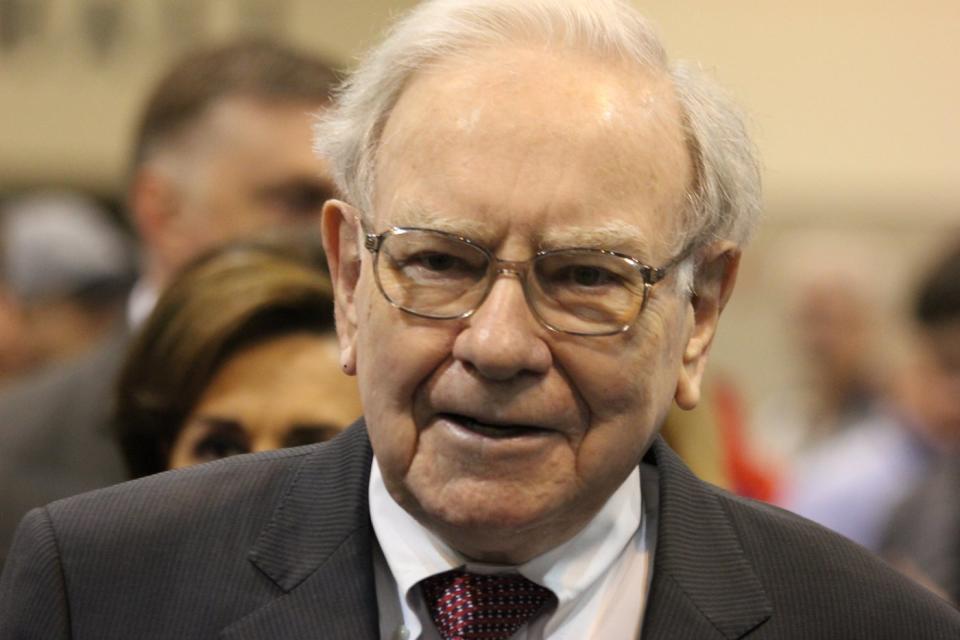46% of Warren Buffett’s $410 Billion Portfolio Is Invested in 4 Artificial Intelligence (AI) Stocks
When it comes to Wall Street investing greats, Berkshire Hathaway (NYSE: BRK.A)(NYSE: BRK.B) CEO Warren Buffett is on a pedestal of his own. Since taking the reins at Berkshire in 1965, he’s overseen a cumulative return in his company’s Class A shares (BRK.A) of 5,028,429%, as of the closing bell on July 10. On an annualized basis, the “Oracle of Omaha” has practically doubled up the total return, including dividends paid, of the benchmark S&P 500 since the mid-1960s.
Buffett’s formula for success primarily involves buying stakes in brand-name, time-tested businesses with well-defined competitive advantages. While this strategy places a lot of emphasis on value stocks, the occasional growth stock does wind up in the 44-stock, $410 billion portfolio Buffett and his team oversee at Berkshire Hathaway.


What might be especially surprising is discovering that Warren Buffett and his cohorts have, at least inadvertently, bet big on the artificial intelligence (AI) revolution.
AI involves the use of software and systems for tasks that humans would typically oversee or undertake. The capacity for these systems to learn and evolve over time, becoming more proficient at their tasks or perhaps learning new skills, is what gives AI such broad-reaching utility.
As of the closing bell on July 10, a whopping 46% ($188.8 billion) of the $410 billion portfolio Warren Buffett oversees at Berkshire Hathaway was invested in four top-notch AI stocks.
Apple: $183.9 billion (44.8% of invested assets)
The lion’s share of Buffett’s exposure to artificial intelligence rests on the shoulders of tech stock Apple (NASDAQ: AAPL), which accounts for close to 45% of Berkshire’s $410 billion of invested assets.
In June, during the company’s annual Worldwide Developer Conference, Apple unveiled what it dubbed “Apple Intelligence.” Though Apple has been leaning on various AI solutions for years, it laid out plans to bring chatbot solutions, powered by ChatGPT, to its operating systems, as well as make its voice assistant Siri a lot more intuitive.
However, the Oracle of Omaha and his team didn’t buy into Apple because of its role in the future of AI. More than likely, Buffett and his close advisors recognized its dominance in smartphones — Apple has sustained a 50% or greater domestic share of the smartphone market since introducing 5G-capable iPhones in late 2020 — as well as the success it’s having in shifting to a services-based model that’s driven by higher-margin subscriptions.
While Apple certainly deserves a premium given its first-mover advantages and cutting-edge innovations, its growth engine has stalled out in recent years. Although it’s possible AI could be the catalyst that reignites growth, Apple’s $674 billion in cumulative stock buybacks since the start of 2013 have done most of the heavy lifting of late.
BYD: $2 billion (0.5% of invested assets)
A second artificial intelligence stock that the Oracle of Omaha and his team have bet big on is China-based electric-vehicle (EV) manufacturer BYD (OTC: BYDD.F). The roughly 65.8 million shares Berkshire holds in BYD equates to a 6% stake in the company, which is worth around $2 billion.
Newer vehicles are becoming increasingly more reliant on technology and AI to improve safety and comfort for drivers. For instance, in mid-January, BYD launched its Xuanji Architecture, which is designed to help drivers with automated parking and other advanced driving assistance technologies.
BYD has also been working with Chinese regulators to test Level 3 autonomous driving on high-speed roads in the city of Shenzhen. U.S. rival Tesla has been stick at Level 2 autonomy for years, despite the continued promises of CEO Elon Musk that Level 5 autonomy is “about one year away.”
What’s been particularly exciting about BYD’s production ramp is that it’s now selling more battery-EVs than Tesla worldwide. While Tesla still retains its first-mover advantages in North America, BYD’s rate of ascension in China has dwarfed all other competitors.


Amazon: $2 billion (0.5% of invested assets)
The third stock that accounts for another multibillion-dollar bet on AI is none other than e-commerce legend Amazon (NASDAQ: AMZN). The 10 million shares of Amazon stock held by Berkshire works out to a market value of roughly $2 billion.
Although most investors are familiar with Amazon because of its dominant online marketplace, cloud infrastructure service platform Amazon Web Services (AWS) is, arguably, its most important operating segment. Generative AI solutions can be leaned on by businesses in AWS to deploy virtual chatbots or assistants and build/scale large language models (LLMs).
The best thing about enterprise cloud spending is that we’re still in the very early innings of its expansion. This is fantastic news considering that AWS has already surpassed $100 billion in annual run-rate sales, and is Amazon’s highest-margin segment.
The company’s other fast-paced ancillary segments are holding their own, too. Advertising services and subscription services offer sustained double-digit growth. Attracting 2.5 billion unique visitors to its website monthly has helped with ad sales, while a growing content library, which now includes Thursday Night Football, has almost certainly lifted the aggregate number of global Prime subscribers.
Snowflake: $842 million (0.2% of invested assets)
The fourth AI stock that, along with Apple, BYD, and Amazon, collectively accounts for 46% of Berkshire Hathaway’s $410 billion of invested assets is cloud data-warehousing company Snowflake (NYSE: SNOW). Similar to Amazon, Snowflake was added to Berkshire’s portfolio by one of Buffett’s investing “lieutenants,” Todd Combs and Ted Weschler.
Last year, Snowflake acquired Neeva, a company that leverages generative AI solutions within the cloud to improve search. Snowflake plans to rely on various generative AI solutions within its data cloud to allow its customers to easily analyze data and build, train, and deploy LLMs.
Beyond its AI ties, the lure of Snowflake as an investment has long been its ingrained competitive advantages. Snowflake built its data cloud atop the world’s leading cloud infrastructure service platforms. Whereas sharing data can be challenging across competing platforms, it’s a breeze with Snowflake.
Likewise, Snowflake has shunned the subscription-as-a-service model in favor of a pay-as-you-go approach. The transparency of businesses only paying for the Snowflake Compute Credits and data storage space used has helped it retain clients and steadily grow its base of bigger businesses.
However, Snowflake is a pricey stock and certainly doesn’t fit the mold of a traditional Warren Buffett investment. Valued at 13 times forecast sales in the current fiscal year, and roughly 139 times earnings per share (EPS) in the following year, Snowflake has a lot to prove to Wall Street.
Should you invest $1,000 in Apple right now?
Before you buy stock in Apple, consider this:
The Motley Fool Stock Advisor analyst team just identified what they believe are the 10 best stocks for investors to buy now… and Apple wasn’t one of them. The 10 stocks that made the cut could produce monster returns in the coming years.
Consider when Nvidia made this list on April 15, 2005… if you invested $1,000 at the time of our recommendation, you’d have $826,672!*
Stock Advisor provides investors with an easy-to-follow blueprint for success, including guidance on building a portfolio, regular updates from analysts, and two new stock picks each month. The Stock Advisor service has more than quadrupled the return of S&P 500 since 2002*.
*Stock Advisor returns as of July 8, 2024
John Mackey, former CEO of Whole Foods Market, an Amazon subsidiary, is a member of The Motley Fool’s board of directors. Sean Williams has positions in Amazon. The Motley Fool has positions in and recommends Amazon, Apple, BYD Company, Berkshire Hathaway, Snowflake, and Tesla. The Motley Fool has a disclosure policy.
46% of Warren Buffett’s $410 Billion Portfolio Is Invested in 4 Artificial Intelligence (AI) Stocks was originally published by The Motley Fool





